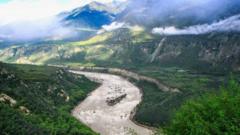The Chinese government has approved the construction of the world's largest hydropower dam on the Yarlung Tsangpo river in Tibet, projected to generate thrice the energy of the Three Gorges Dam. Concerns about community displacement, environmental damage, and geopolitical tensions have emerged as activists and experts warn of the negative repercussions on both local populations and downstream countries, including India and Bangladesh.
China Greenlights Ambitious Hydropower Project Amidst Environmental and Human Rights Concerns

China Greenlights Ambitious Hydropower Project Amidst Environmental and Human Rights Concerns
The largest hydropower dam in the world is set to be constructed in Tibet, raising alarms over potential displacements and ecological impacts across neighboring regions.
China has officially embarked on a monumental project set to become the world's largest hydropower dam, located in Tibet along the Yarlung Tsangpo river. This initiative, which promises a power output three times greater than that of the illustrious Three Gorges Dam, has catalyzed a host of concerns pertinent to environmental preservation and community displacement.
State media in China asserts that the project prioritizes ecological protection and local development, claiming it aligns with the nation’s climate neutrality ambitions. However, the plan has been met with stark criticism from human rights advocates and experts who caution against its potential destructive impact on local communities and ecosystems, particularly in a region renowned for its biodiversity.
First proposed in late 2020, the dam's construction has already ignited protests, reminiscent of past conflicts over Chinese infrastructure projects in Tibet. Activists have condemned the development as a stark illustration of China's exploitation of Tibetan resources and have noted oppressive governmental actions against dissent. A recent instance saw hundreds of Tibetans detained following their protests against another hydropower initiative, reflecting ongoing tensions in the region following Beijing's annexation in the 1950s.
Amidst reassurances from authorities that the Yarlung Tsangpo dam will be environmentally benign, questions remain unanswered regarding the number of residents who will be forced to relocate. Historical precedents, such as the Three Gorges project, which displaced 1.4 million people, cast a long shadow.
The engineering challenges associated with the dam are considerable; it will necessitate drilling four 20km tunnels through the tectonically active Namcha Barwa mountain range. The project not only aims to tap into the river’s substantial hydropower potential—evidenced by a significant elevation drop over a short distance—but also raises fears about China's potential control over the transboundary water flow, affecting states like India and Bangladesh.
A 2020 analysis by the Lowy Institute underscored this concern, indicating that Chinese control of Tibetan rivers poses an economic chokehold on India. In response to growing unease, India has reportedly begun exploring its own large-scale dam initiatives.
Despite its plans, China's foreign ministry has maintained that the country holds a legitimate right to manipulate the river's course while claiming to consider environmental ramifications for downstream nations. As the Yarlung Tsangpo river is already home to several existing hydropower stations, this latest development pushes the boundaries of engineering feasibility in what is recognized as Earth’s deepest canyon.
As the project moves forward, serious apprehensions linger regarding the stability of the region, particularly due to the earthquake-prone nature of its geology. Experts caution that extensive construction could spur increased landslide incidents, posing operational risks to the dam itself. With a projected cost reaching up to a trillion yuan ($127 billion), the implications of this undertaking extend far beyond energy production, intertwining economic ambitions with pressing socio-environmental issues in a delicate geopolitical landscape.




















